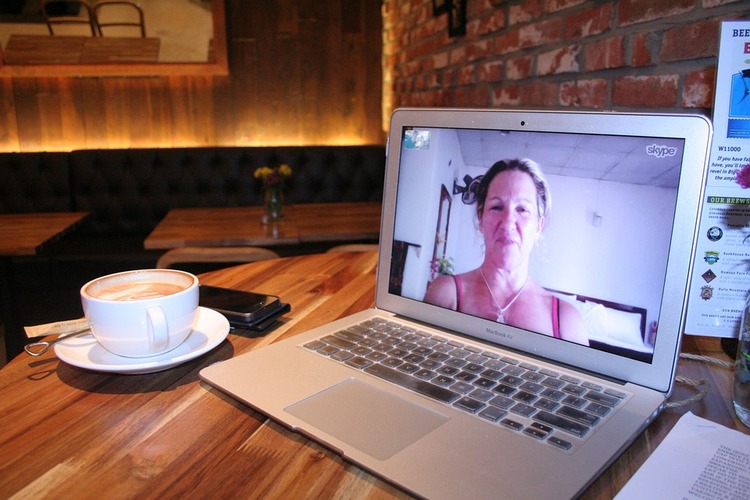Will Blockchain Video Conferencing Make Video Chats More Secure?

You can’t trust the internet. We all know it, and yet we use it hundreds of times a day without feeling any anxiety in the moment. We’ve come to accept an implicit risk in every transaction we make online, from banking to social media, and we ride our luck–like trusting other drivers on the roads to do the right thing.
But what if we had access to an internet where we didn’t need blind trust? What if there was an internet without “middlemen” between us and the friends, businesses, and entertainment we seek?
Blockchain technology is being promoted as the magic sauce that will make this hypothetical world a reality. It’s often referred to as a “trustless” network because every transaction made within a specific system is recorded and shared among the entire group–no one has to be taken at their word and no one controls any central gateway all must pass.
Blockchain is near-universally praised as a new level of security for digital transactions, one strong enough to support the entire Bitcoin currency system, which begs the question–could blockchain video conferencing be the most secure way to communicate in the future?
Blockchain Explained
At its most basic, blockchain technology is a shared record of transactions, all chained together so that they cannot be broken. You just have to slightly tweak the way you understand a few of those terms in order to fully understand the technology.
By “shared” I mean everybody, or rather every computer, within a system has a duplicate copy of this record book that is updated instantly–there’s no single reserve all can access. Each record exists individually and is of equal importance.
Every action that occurs within a system is noted in every copy of the record, and every action must be authorized by every other record book keeper. These actions are then “chained” together permanently like the lines of a novel in which each new set of words is dependant on the ones before and after.
Most people associate blockchain technology with digital currency like Bitcoin, but since blockchain deals in digital information, it can be applied to all sorts of online transactions, including video conferencing.
Blockchain Video Conferencing Is in the Works
At the heart of every video conference is an exchange of digital information. The webcams and microphones you use retransform the analog data of your voice and image into digital bits that can be cut up, packaged, and sent over the internet to where your friend’s device can receive and unpack it all.
In every conversation, there’s a sender, a message, and a receiver. And blockchain is great at keeping track of all that information. Paired with end-to-end encryption, which grants unique little passwords to each end of a connection to keep it safe, blockchain promises a new level of video chatting security.
Several companies are already starting to build blockchain-based messaging and video apps to win the business of security-conscious WhatsApp and Snapchat users. PeerStream, Inc. (formerly Snap Interactive), for example, will launch Backchannel toward the end of this year. Backchannel will eventually be able to host one-on-one video calls over mobile. Going even further, under-development app e-Chat will soon perform the same video call trick with up to 10 people.
Those apps and their blockchain peers are a long way from replicating enterprise-scale video conferencing, but they are proof that there’s momentum building toward next-generation security for video.
Other Options for Video Conferencing Security
The current video conferencing security workload is shouldered by internal firewalls, “meeting lock” software–like that deployed by consumer VC vendor BlueJeans–and the type of end-to-end encryption that Skype is introducing across its platform.
In addition to these applications of existing security measures, there are also a couple of other technologies with potential. China recently staged the world’s first intercontinental video conference using quantum physics, a system researchers say is unshakable. And then there is the continued advancement of facial recognition. While not as data-centric as blockchain or encryption, high-end webcams are already being used to help create biological passwords based on unique human features. With an improvement of live AI technology, facial recognition could one day be deployed in-call to keep tabs on who’s on-screen.
All those security measures act within the existing internet system. Blockchain, by comparison, is a whole new network. As such, its adoption is likely to be dependant on the rise of entirely new apps, like those listed above. That, in turn, will likely slow its spread. Facebook Messenger, for instance, can’t suddenly upend its entire operating system to incorporate blockchain, despite how much the company could use a new security promise. Is heightened security enough to sway the hundreds of millions of WhatsApp and Snapchat users away from their established circles of friends and onto to whole new network? It would appear unlikely. The same need for upheaval applies to the business world as well, where legacy video conferencing systems would need to be replaced with entirely new VC vendors.
For all its obvious potential, blockchain is in for a slow build. Like we said at the beginning, everyone knows you can’t trust the internet, but we’re so comfortable in our current ways we’re still willing to take digital risks. It’s likely to take a lot of time–and a lot of security scares–to make blockchain ubiquitous.
Source: videoconferencingdaily
